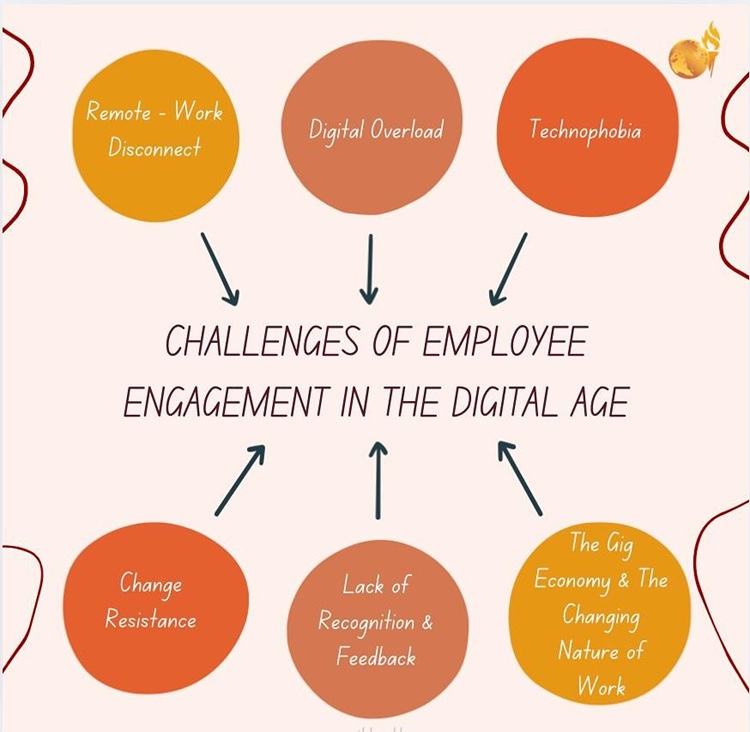In today’s digital workplace, keeping employees engaged is crucial. This article explores strategies to motivate, connect, and empower your workforce for peak performance.
While recent technological advancements offer numerous benefits, they also present challenges in fostering a strong sense of employee engagement. A disconnected and disengaged workforce can lead to decreased productivity, higher turnover, and a negative impact on your bottom line. That said, with effective strategies in place, organizations may still cultivate a thriving workplace where people feel valued, motivated, and empowered to do their best work.
|
Author: Jonathan M. Pham |
Highlights
- Employee engagement in the digital age is about leveraging technology to keep a geographically spread workforce connected, motivated, and productive. It is crucial for driving innovation, productivity, collaboration, and attracting top talent – thereby laying the foundation for sustainable business growth.
- Technology is a powerful tool for engagement; yet it requires careful management to avoid burnout, isolation, and information overload.
- Due to challenges such as remote disconnect, information overload, and resistance to change, companies are required to adapt the approach to keep their members motivated. Strategies they may deploy include two-way communication, training that bridges skill gaps, personalized learning, recognition for using new tech, and investment in well-being to combat burnout.
- Leaders who embrace new tech, communicate openly, tolerate risk, and prioritize people development play a crucial role in driving successful transformation.
What is Digital Employee Engagement?
These days, the way we work has fundamentally changed due to the rise of remote work, online communication tools, and automation. As such, companies are required to rethink their strategies for ensuring employee engagement – which refers to one’s dedication, enthusiasm, and commitment to their work and organization.
Digital employee engagement specifically focuses on utilizing technology to cater to a more connected and dispersed workforce – ultimately leading to a more connected and productive employee base. This involves leveraging tools and platforms to:
- Facilitate communication and collaboration: Make it easy for employees to connect, share ideas, and work together effectively, regardless of location.
- Provide recognition and appreciation: Acknowledge team members’ achievements and contributions.
- Promote learning and development: Offer online training programs, knowledge-sharing sessions, and opportunities for continuous learning.
- Empower: Give people a sense of ownership and control over their work through digital tools.
- Create a sense of community: Foster a sense of belonging and connection, even in a remote or hybrid work environment.
Example:
A company decides to establish an Intranet system that is used to publicly recognize achievements. Additionally, team members may leverage it to share project updates, ask questions, and participate in virtual team-building activities – regardless of physical location.
Some examples of digital employee engagement tools:
- Communication platforms: Collaboration tools, internal social networks, video conferencing software.
- Feedback and recognition tools: Pulse surveys, recognition platforms, gamification elements.
- Learning and development platforms: Online courses, knowledge management systems, microlearning tools.
- Wellness and productivity tools: Mindfulness apps, fitness trackers, time management apps.
Importance of Employee Engagement in the Digital Age
Employee engagement has always been a key factor of business success – yet these days, it has become even more critical. The business landscape is constantly changing; as such, organizations are in dire need of people who are capable of adapting and innovating quickly. Engaged employees are more likely to go the extra mile, think creatively, and solve problems effectively. This not only leads to higher quality work and service – but also translates to a happier and more stable workforce with lower turnover rates, reduced costs, and a positive employer brand that attracts top talent.
As reported by Deloitte, a study by Forbes and Microsoft suggests that digitally empowered frontline employees are 3 times more likely to deliver over 20% annual growth. On the other hand, research by McKinsey found that companies that embrace collaborative technologies see a 20-30% increase in productivity. When team members are invested in their work and equipped with the right tools to excel, they become powerful drivers of growth for the company – by taking ownership of their work, contributing more creatively, and collaborating with better efficiency. This is especially true for younger generations like Millennials and Gen-Z – who are inherently tech-oriented and thus often frustrated with clunky software/ unclear communication channels typically observed in previous organizational systems.

Employee engagement in the digital age
Read more: Talent Management – Key to Business Success
How Does Technology Impact Employee Engagement?
Despite its impressively transformative impact, technology has been found to be a double-edged sword when it comes to employee engagement.
Positive effects:
- Improved Collaboration and Communication: Tools like video conferencing, project management platforms, and instant messaging enable seamless communication and teamwork regardless of location. This contributes to fostering a more connected and engaged workforce.
- Enhanced Productivity and Efficiency: Automation, streamlined workflows, and knowledge-sharing platforms empower team members to focus on high-value tasks and complete them efficiently – which gives rise to a sense of accomplishment.
- Learning and Development Opportunities: Online courses, learning management systems, and access to industry resources make it possible for employees to be equipped with the skills they need to grow and contribute more, leading to higher engagement.
- Work-Life Balance and Flexibility: Technologies like cloud storage and remote work tools allow people to work anytime, anywhere. This flexibility translates to a better likelihood of attaining work-life balance and satisfaction.
Consideration points:
- Always-On Culture and Burnout: Constant connectivity through technology has been observed to blur the lines between work and personal life, which – if left unchecked – will lead to stress and burnout.
- Social Isolation and Lack of Human Connection: Overreliance on digital communication decreases in-person interaction – thereby giving rise to feelings of isolation and a downgraded team spirit.
- Tech Overload and Information Fatigue: Information overload from multiple channels may overwhelm employees and make it difficult to focus on priorities.
Challenges of Employee Engagement in the Digital Age
The digital age has introduced a new set of hurdles for keeping employees engaged, including:
- Remote Work Disconnect
Challenge: Physical distance makes it difficult for remote employees to feel connected to colleagues and company culture.
Solutions: Encourage virtual team-building activities, utilize video conferencing for meetings and informal chats, and establish communication channels specifically for social interaction.
- Digital Overload
Challenge: The constant barrage of emails, notifications, and instant messaging creates information overload and stress.
Solutions: Promote practices like designated “focus time” without interruptions, encourage employees to set boundaries on work availability outside of core hours, and implement tools that streamline communication and reduce redundant messages.
- Technophobia
Challenge: Some employees may be uncomfortable or struggle to learn new technologies.
Solutions: Provide comprehensive training programs and ongoing support for new technology adoption. Offer different learning styles (video tutorials, in-person workshops) to cater to individual needs. Foster a culture of open communication where employees feel comfortable asking questions.
Challenge: Employees may resist adopting new tools and processes due to fear of the unknown or a preference for the familiar.
Solutions: Involve employees in the decision-making process for new technologies whenever possible. Clearly communicate the benefits of change and how it will improve their work experience – and consider offering incentives for early adopters.
Read more: Change Management – How to Champion It
- Lack of Recognition and Feedback
Challenge: In a remote or fast-paced digital environment, recognition and feedback are often not provided regularly enough – which leaves employees feeling unseen/ underappreciated and negatively impacts their motivation and engagement level.
Solutions: Regularly acknowledge employee contributions, both big and small. Implement performance management systems that provide ongoing feedback and development opportunities. Utilize technology for virtual recognition programs or shout-outs.
- The Gig Economy and the Changing Nature of Work
Challenge: The rise of the gig economy and freelance work can lead to feelings of isolation and a lack of connection to a traditional company culture.
Solutions: For companies with a large freelance workforce, consider creating online communities or forums for freelancers to connect and share knowledge. Additionally, it may be worth offering benefits or perks to freelancers to foster a sense of belonging.
Read more: Visibility at Work – Key to Career Advancement

How to Engage Employees in the Digital Age
Communication strategies
Engaging employees in today’s digital landscape requires a shift from traditional, one-way communication. The key lies in fostering a two-way dialogue. Organizations need to move away from simply delivering pronouncements from the top down. Instead, they should encourage feedback through surveys, polls, and interactive town halls. By giving your team members a voice and keeping them informed about the company’s goals, progress updates, and even challenges, you create a sense of ownership and investment in collective success.
Technology is a powerful tool for fostering this engagement. Channels like collaboration tools, internal social media platforms, and instant messaging are particularly useful for keeping remote teams connected and informed. Instead of lengthy meetings, opt for frequent, bite-sized updates. Bulletins, short video messages, or even an internal podcast can effectively deliver information while keeping people engaged.
On the other hand, it is also recommended that companies consider organizing online social events, virtual game nights, or remote brainstorming sessions to build connections and camaraderie among geographically dispersed teams.
Training and Development
Given the current ever-evolving business landscape, equipping your people with the proper competencies is crucial for both their engagement and the organization’s success. Here’s a three-pronged approach to training and development that fosters engagement:
- Bridge the Digital Skills Gap
Identify exactly what skills are needed by conducting surveys and assessments (e.g. knowledge of CRM functionalities and data analysis). Once you understand the gaps, you may then move on to providing targeted solutions. Offer a variety of engaging options like online courses, workshops, and even coaching or mentorship programs to equip employees with the necessary competencies.
- Microlearning Opportunities
Today’s busy schedules demand flexibility in learning. Microlearning provides bite-sized, easily digestible modules on new technologies or processes. These short bursts of learning are perfect for on-the-go consumption and keep information engaging and manageable.
- Personalized Learning Paths
A one-size-fits-all approach to training doesn’t work for a motivated workforce. Rather, develop personalized learning plans tailored to individual roles and career aspirations. This demonstrates a commitment to employee growth and fosters a sense of investment in their future with the company.
For example, let’s say you have a customer service representative named Sarah who aspires to become a marketing specialist. Through performance reviews and discussions, you discover her strengths lie in written communication and social media engagement. Based on this discovery, you offer her the chance to participate in courses on content marketing, social media advertising, and copywriting – instead of generic customer service training. At the same time, you provide Sarah with opportunities outside her typical role (e.g. writing blog posts, managing social media campaigns, or assisting with email marketing initiatives) – and pair her with a marketing specialist who can provide guidance and answer questions as she navigates marketing concepts. This approach fosters a sense of loyalty and motivates her to excel in her current role – while preparing for the future she envisions within the company.
Recognition and Rewards
In the digital age, keeping employees engaged with new technologies requires a focus on both recognition and rewards. Acknowledging those who become early adopters sets a positive tone. Public recognition, like shout-outs in company meetings or features in internal newsletters, highlights their initiative and encourages others to follow suit.
Gamification adds another layer of engagement. By implementing point-based systems or friendly competitions around learning new tools, organizations make the process more fun – while also fostering a sense of healthy competition. This approach capitalizes on the natural human desire to achieve and thus significantly boosts participation in training initiatives.
Finally, rewards should go beyond traditional financial incentives. While bonuses are always appreciated, offering flexible work arrangements, additional paid time off, or even badge systems tied to digital adoption goals can be highly motivating. These rewards cater to the diverse needs of a modern workforce and demonstrate the company’s commitment to employee well-being and work-life balance.
Invest in Well-being
The constant barrage of information and pressure to stay connected in the digital age is a reason behind the prevalence of workplace burnout. To combat this issue, companies must prioritize well-being initiatives – starting with acknowledging the reality of information overload and digital fatigue. Employees need to feel supported in setting boundaries between work and personal life.
Promoting healthy work-life balance may take shape in several ways. Organizations may encourage team members to disconnect after work hours and during vacations. This can involve setting clear expectations around email response times and respecting designated off-line periods. Additionally, offering flexible work arrangements, such as remote work options or compressed workweeks, empowers individuals to manage their workloads and personal lives more effectively.
Finally, investing in resources for mental well-being demonstrates your commitment to people’s overall health. This could include providing access to meditation apps or subscription services for online therapy. By offering these resources and fostering a culture that prioritizes mental health, companies are equipped to create a more engaged and productive workforce.

Employee engagement in the digital age
The Role of Leadership in Engaging Employees in the Digital Age
In the digital age, leadership plays a pivotal role in fostering employee engagement. Leaders set the tone for the organization’s digital transformation journey, and their actions directly impact how team members embrace new technologies and processes.
Below are a few things they can do to make a difference:
- Digital Fluency: Leaders themselves should be comfortable using new technologies and demonstrate a willingness to learn. This sends a powerful message that digital adoption is a company priority.
- Open Communication: Leaders should be transparent about the digital transformation goals and actively solicit feedback from employees – so as to foster trust and a sense of ownership.
- Risk Tolerance and Experimentation: A culture where calculated risks and experimentation are valued should be encouraged to promote innovation.
- Invest in Training and Development: Leaders should champion learning and development initiatives that bridge the digital skills gap. Additionally, they should spend time mentoring and coaching their teams on using new technologies – so as to foster confidence and smoother digital adoption.
- Psychological Safety: A safe environment where individuals feel comfortable asking questions, making mistakes, and learning from them is crucial for bringing about a culture of continuous learning.
Read more: Human Leadership in a Digital World – Skills & Strategies
The Future of Employee Engagement: How AI and Automation Will Reshape the Landscape
Employee engagement, a crucial factor in productivity and retention, is poised for a significant shift with the rise of artificial intelligence (AI) and automation. Here’s how these emerging technologies might impact the future of work:
- Rise of the Human-Machine Partnership
AI is capable of automating repetitive tasks, thereby freeing up time for more strategic and creative work. This can lead to higher engagement as employees feel challenged and have a greater sense of purpose.
However, a poorly managed transition will lead to job displacement and anxiety. Organizations will need to focus on reskilling and upskilling their workforce to ensure a smooth transition.
- Personalized Learning & Enhanced Communication
Due to AI’s ability to personalize learning experiences catering to individual strengths and weaknesses, employees may feel valued and invested in their growth. At the same time, over-reliance on AI for training may cause a disconnect between employees and their managers. As such, human interaction remains crucial for mentorship and guidance.
Overall, AI and automation hold immense potential to improve employee engagement. However, organizations must ensure a human-centric approach that leverages technology to empower employees, not replace them.

Employee engagement in the digital age
Final Thoughts
In the digital age, prioritizing employee engagement is no longer a choice, it’s the key to unlocking your company’s full potential. By implementing the strategies outlined above, businesses are better equipped to foster a work environment that not only attracts top talent but also empowers them to thrive!
Other resources you might be interested in:
- Organizational Transformation: An Essential Guide
- HR Transformation: Future-Proof People Strategy
- Talent Transformation: Build a Future-ready Workforce
- Future Ready Organization: 11 Tips to Building One

